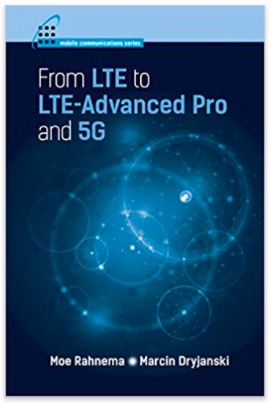While 5G has become the darling of conferences, press releases and analyst briefings — its touted use cases tantalizing the imagination — the older sibling, LTE, can certainly relate to Mark Twain’s oft-quoted and wry comment, “The reports of my death are greatly exaggerated.” The evolution of LTE, to LTE-Advanced and LTE-Advanced Pro, is addressing two of the broad goals for 5G: enabling higher data rates and IoT connections. And the first version of 5G to be deployed, the non-standalone architecture, will use the existing LTE network, except for the radio.

In 14 chapters, From LTE to LTE-Advanced Pro and 5G provides a comprehensive discussion of the workings of LTE, addressing the air interface, evolved packet core (EPC) network architecture, protocols, network planning and optimization and the transition LTE is providing to 5G.
After a tutorial on the fast Fourier transform (FFT) and the discrete time Fourier transform (DFT), central to signal processing in digital communications systems, the subsequent chapters cover the air interface architecture and operation; coverage-capacity planning and analysis; prelaunch parameter planning and resource allocation; radio resource control and mobility management; inter-cell interference management; SON technologies; EPC network architecture, planning and dimensioning; LTE-Advanced enhancements; optimization for TCP operation; voice over LTE (VoLTE); LTE-Advanced Pro enhancements; and the transition to 5G.
Collectively, the authors have decades of experience in wireless telecommunications. As an independent consultant for the past 15 years, Moe Rahnema has worked with the major network equipment manufacturers and various operators to plan and optimize cellular networks. He was recognized by Huawei for his work planning the first LTE network in Mexico. Marcin Dryjanski has been an architect for physical layer and L2/L3 protocol stack software for LTE and LTE-Advanced. More recently, he supported 5G design through the EU research programs 5GNOW and SOLDER and is consulting with Huawei on algorithm and RAN architectural designs for LTE-Advanced Pro and 5G.
I had the opportunity to speak with Moe and Marcin on Wednesday, 20 December. We discussed the genesis of the book, whether 5G is truly a revolution and the authors’ feelings about being part of the mobile transformation of society. Listen to our conversation.
Order the book From LTE to LTE-Advanced Pro and 5G from Artech House.

